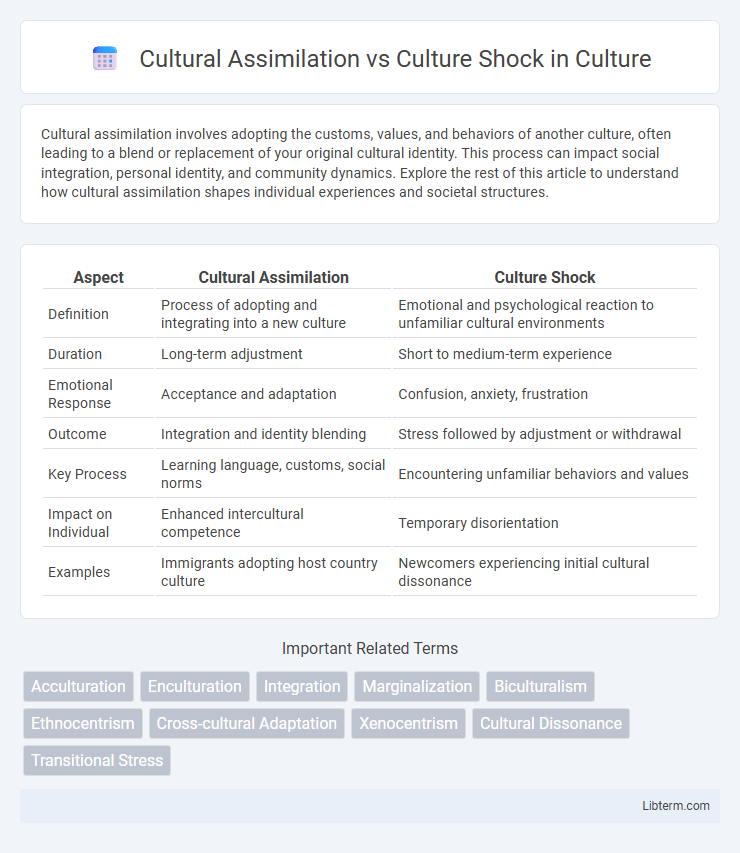Cultural assimilation involves adopting the customs, values, and behaviors of another culture, often leading to a blend or replacement of your original cultural identity. This process can impact social integration, personal identity, and community dynamics. Explore the rest of this article to understand how cultural assimilation shapes individual experiences and societal structures.
Table of Comparison
| Aspect | Cultural Assimilation | Culture Shock |
|---|---|---|
| Definition | Process of adopting and integrating into a new culture | Emotional and psychological reaction to unfamiliar cultural environments |
| Duration | Long-term adjustment | Short to medium-term experience |
| Emotional Response | Acceptance and adaptation | Confusion, anxiety, frustration |
| Outcome | Integration and identity blending | Stress followed by adjustment or withdrawal |
| Key Process | Learning language, customs, social norms | Encountering unfamiliar behaviors and values |
| Impact on Individual | Enhanced intercultural competence | Temporary disorientation |
| Examples | Immigrants adopting host country culture | Newcomers experiencing initial cultural dissonance |
Understanding Cultural Assimilation
Cultural assimilation involves the process by which individuals adopt the cultural traits or social patterns of another group, often leading to the integration into the dominant culture. It encompasses changes in language, customs, values, and behaviors to fit within the new cultural environment, resulting in a shared identity. Understanding cultural assimilation provides insight into the challenges and adaptations immigrants and minorities face in achieving social cohesion and acceptance.
Defining Culture Shock
Culture shock refers to the psychological and emotional disorientation experienced when encountering an unfamiliar cultural environment, marked by feelings of anxiety, confusion, and homesickness. It commonly occurs during international relocation or extended stays in foreign countries, challenging an individual's ability to adapt to new social norms, language barriers, and differing customs. Understanding culture shock is essential for facilitating smoother cultural assimilation and promoting mental well-being in multicultural contexts.
Key Differences Between Assimilation and Culture Shock
Cultural assimilation involves the gradual adoption of a new culture's norms, values, and behaviors, leading to integration within the host society. Culture shock is the initial psychological disorientation and stress experienced when encountering a vastly different cultural environment. Key differences include assimilation's long-term adaptation process versus culture shock's short-term emotional response, with assimilation fostering cultural blending and culture shock causing temporary alienation or confusion.
Stages of Cultural Assimilation
Cultural assimilation involves stages such as the honeymoon phase, where individuals feel excitement about the new culture, followed by the negotiation phase marked by challenges and frustration as differences become apparent. The adjustment phase comes next, characterized by learning to navigate and adapt to the cultural norms, leading to eventual mastery, where the individual feels comfortable and integrated into the new culture. Understanding these stages helps mitigate culture shock, reducing anxiety and improving cross-cultural communication and adaptation.
Phases of Culture Shock
Culture shock typically unfolds in four distinct phases: honeymoon, negotiation, adjustment, and mastery, reflecting the emotional and psychological stages a person experiences when immersed in a new culture. The honeymoon phase involves initial excitement, followed by the negotiation phase where differences cause frustration and anxiety. During adjustment, individuals develop coping strategies and cultural competence, ultimately reaching mastery, where they fully integrate behavioral norms and feel comfortable in the new cultural environment.
Factors Influencing Cultural Assimilation
Factors influencing cultural assimilation include language proficiency, social integration, and openness to new experiences. Access to education, employment opportunities, and support networks also significantly affect the assimilation process. Additionally, cultural similarity and community acceptance play crucial roles in facilitating smoother adaptation to a new culture.
Coping Mechanisms for Culture Shock
Effective coping mechanisms for culture shock include developing cultural awareness, building social support networks, and practicing mindfulness to manage stress. Engaging in language learning and participating in local traditions promote smoother cultural adaptation. Seeking professional counseling or peer support groups can significantly alleviate the psychological impact of culture shock.
Psychological Impact of Assimilation and Culture Shock
Cultural assimilation often leads to significant psychological stress as individuals suppress their native identity to conform to the dominant culture, resulting in anxiety, loss of self-esteem, and identity confusion. Culture shock manifests through emotional disorientation, homesickness, and frustration as individuals struggle to adapt to unfamiliar social norms and communication styles. Both processes can induce mental health challenges such as depression and social isolation, highlighting the importance of coping strategies and psychological support during cultural transitions.
Real-Life Examples of Assimilation and Culture Shock
Immigrants moving to Japan often experience culture shock due to its unique social etiquette, such as bowing and removing shoes indoors, contrasting with Western customs they are accustomed to. In contrast, Indian expatriates in the United States may undergo cultural assimilation by adopting English language fluency and participating in American holidays, blending their traditions with mainstream culture. These real-life examples highlight how individuals navigate the challenges of adapting to new environments, balancing cultural preservation with integration.
Strategies for Navigating New Cultures
Effective strategies for navigating new cultures include actively engaging in cultural immersion and practicing open-minded communication to minimize culture shock. Developing cultural intelligence by learning local customs, language nuances, and social norms fosters smoother cultural assimilation. Seeking support networks within the community and maintaining mindfulness of cultural differences enhance adaptability and ease the transition into a new cultural environment.
Cultural Assimilation Infographic

 libterm.com
libterm.com